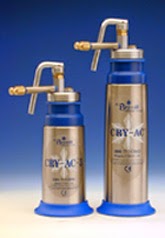Cryotherapy
Cryotherapy or ice therapy is the
application of cold to the body tissues after injury. This practice is as old
as medicine itself. Nowadays, local cold application may be applied by the use
of various forms of ice or frozen gel packs, sprays or by evaporation of
volatile fluids from the skin. Often skin temperature is reduced to 10 C°.
Uses of Cryotherapy
•
Reduces pain.
•
Reduces spasticity.
•
Reduces muscle
spasm.
•
Reduces swelling.
•
Promote repair of
the damaged tissues.
•
Provide
excitatory stimulus to inhibited muscles.
Reduction of Pain
Pain reduction (for instance) is one of
the major benefits of cryotherapy. The probable mechanism is that by the
stimulation of cold receptors, impulses will be send back which will pass into
the posterior root of the spinal cord. These impulses, arriving through large
diameter nerves, effectively block out any other (pain) impulses attempting to
access the spinal cord (pain gate theory). This reduces the pain temporarily.
For permanent pain relief, positive physiotherapy (strengthening, mobilization)
has to be given during this period of transient pain relief.
Techniques of Application of
Cryotherapy
The way which ice is applied will vary
according to the required effects. It may be applied in the following ways:
–
Ice towels
–
Ice packs
–
Immersion
–
Ice cube massage
–
Excitatory cold (
quick ice)
–
Ice spray
–
Cold gel
Don’t Allow Ice Treatment If You Have
The Following Conditions:
•
Cardiac
Conditions
•
Psychological
Issues
•
Peripheral Nerve
Injuries
•
Vasospastic
Disease
•
Peripheral
Vascular Disease
•
Cold Sensitivity
Physiological Effects of Cryotherapy
•
Circulatory
Response
•
The initial skin
reaction to cooling is an attempt to preserve heat. It is accomplished by an
initial vasoconstriction (haemostatic response). After a short period of time,
the duration depends on the area involved; a vasodilatation follows with
alternating periods of constriction and dilatation. This reaction of “hunting”
for a mean point of circulation is called “Lewis’s Hunting Reaction”.
•
During the
vasodilatation, the arteriovenous anastomosis is closed, thus causing an
increase blood flow through the capillaries. This is beneficial in the
treatment of swelling and tissue damage.
•
Neural
response
•
The skin contains
primary thermal receptors. Cold receptors are several times more numerous than
warm receptors. The cold receptors respond to cooling by a sustained discharge
of impulses, the rate of which increases with further cooling.
•
The rate of
conduction of nerve fibers in a mixed (motor and sensory) peripheral nerve is
reduced by cooling. The first fibers affected by gradual cooling are the A
fibers (myelinated) and eventually at very low temperatures the B and C fibers
(non-myelinated) are affected.
•
In practice,
motor nerve paralysis is never produced by ice.
Is
Physiotherapist the same as masseurs?
No! We are not, just like cryotherapy, massage
is one of the numerous techniques in physiotherapy (see: Physiolight Edition
1).
NEXT
ISSUE: PROGRESSIVE RESISTIVE EXERCISES



This is a fantastic website. This blog provides useful information on what Cryotherapy is and how to obtain it. Thank you for making this information available.
ReplyDeleteCryotherapy or ice therapy involves applying cold to body tissues after an injury, a practice as old as medicine itself. Nowadays, local cold application can be done using various forms of ice, frozen gel packs, sprays, or by evaporation of volatile fluids from the skin. Often, skin temperature is reduced to 10°C. A ice bath chiller can enhance this experience, providing consistent and controlled cooling for optimal recovery.
ReplyDelete